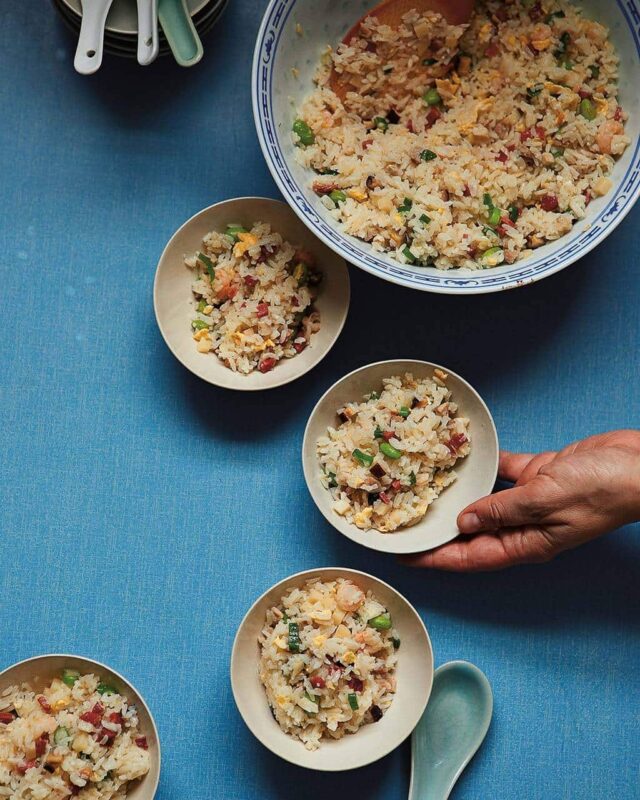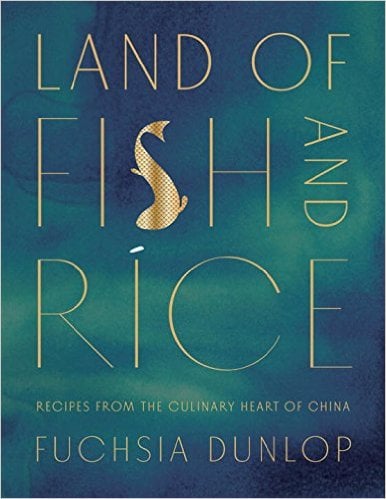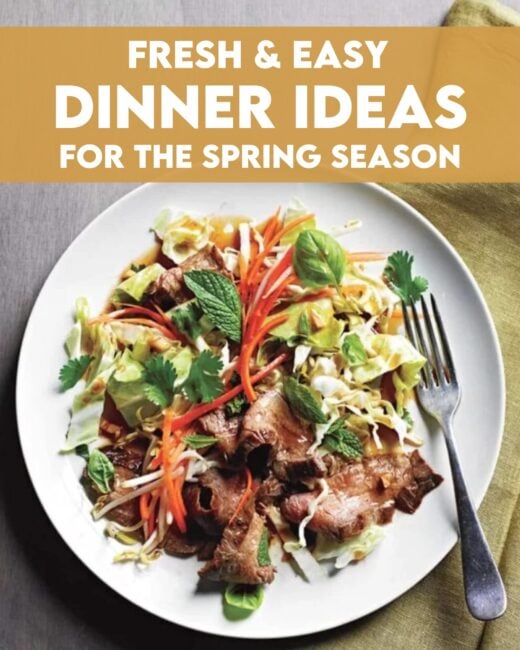Yangzhou fried rice from Jiangsu Province is the most famous variety of fried rice in China. This Yangzhou Fried Rice recipe has all the good stuff – pork, chicken, shrimp and so much more! A really special, special fried rice.

Why This Yangzhou Fried Rice Recipe Is So Good
- An authentic and insanely popular Chinese rice dish
- Perfectly light and fluffy rice
- Better than take out special fried rice
- Hearty and easy to make – just 20 mins from pantry to table
Ingredients
- Shitake mushrooms
- Pork tenderloin
- Peeled shrimp
- Cooked ham
- Cooked chicken
- Green onion
- Egg
- Cooked rice
- Cooking oi
- Peas
- Rice wine
- Chicken stock
- Salt and ground white pepper
How To Make This Yangzhou Fried Rice – Step By Step
- Cut the pork, shrimp, ham, chicken, mushroom, if using, into small dice. Thinly slice the spring onion greens. Beat the egg with a little salt and pepper. Break the rice up into small clumps to make it easier to fry.
- Heat 2 tablespoons of the oil in a wok over a high flame. Add the pork and stir-fry briefly until the pork is pale. Add the ham, chicken, shrimp, mushrooms, peas, and continue to stir-fry for 1–2 minutes, until everything is hot and sizzling. Add the Chinese rice wine, then pour in the stock and bring to the boil. Season with salt, then pour off into a bowl and set aside.
- Rinse and dry the wok and return it to the heat with the remaining oil. When the oil is hot, add the beaten egg mixture and swirl it around the base of the wok. When the egg is half-cooked, add the green onions and all the rice and stir-fry, breaking up any clumps.
- When the rice is very hot, smells delicious and makes a popping sound around the edges of the wok, add the reserved ingredients in their stock sauce. Mix well and continue to stir-fry for another 30 seconds or so, seasoning with salt or pepper if you wish.
What is Yangzhou Fried Rice?
Yang zhou chao fan 扬州炒饭 is a fried rice dish that features egg along with leftover bits of ham, shrimp and meat. At Chinese restaurants in America, sometimes the dish is simply referred to as, “House Fried Rice.” Ingredients may differ from day to day, depending on what leftover protein is available.
Yangzhou Fried Rice was invented by Qing China‘s Yi Bingshou (1754–1815) and the dish was named Yangzhou fried rice since Yi was once the regional magistrate of Yangzhou (source)
A Traditional Fried Rice Recipe
This version omits the hard-to-find luxuries of sea cucumber and freshwater crabmeat, but otherwise follows the traditional method. If you want to make the totally authentic version, add ¾ oz (25g) chopped, soaked dried sea cucumber and ¾ oz (25g) freshwater crabmeat, and substitute tiny freshwater shrimp for the saltwater shrimp.”
Yangzhou Fried Rice – Better Than Takeout!
Make this at home because what’s better than a recipe that comes together in just 20 minutes? That’s quicker than Uber Eats! If you have all of your ingredients prepped beforehand, this meal is almost instant. The next time you’re doing meal prep for the week, make some extra rice and chop up some Chinese sausage – you’ll be halfway to homemade weeknight fried rice.
Top Tips For Yangzhou Fried Rice
- I prefer scrambling the egg separate from the rice — I get a better result with a lighter texture and fluffier rice. Many times, if your wok or pan is not hot enough, and you add the egg on top of the rice, “silver wrapped in gold (jin guo yin)” – you might end up with mushier, wetter fried rice.
- Make sure you use leftover rice, that’s been previously refrigerated. This also helps with making a lighter fried rice with grains separated. If you use steaming-hot, freshly cooked rice, you’ll end up with a goopy mess. That’s because the refrigerator dries out the rice a bit – which is a good thing, because we are adding liquid to the fried rice (chicken stock, Chinese rice wine). You’ll get best results with Jasmine rice, or other medium grained rice. Short-grained rice (used in sushi, Japanese or Korean cooking) is fine too, but not normally used in this recipe. Short grained rice is a little heavier and stickier.
- Ingredients are cooked separately, then added all back together for a very specific reason. If you throw all the ingredients into the wok and try to cook everything at once, the rice will end up tasting like mish-mash. Also, different ingredients have different cooking times — by the time the pork is cooked through, your chicken will be overcooked. Authentic Chinese fried rice allows you to taste each and every ingredient – so that the shrimp tastes like shrimp….and the egg tastes like egg.
- Instead of seasoning with soy sauce, the fried rice is flavored with chicken stock. The stock is added to the ingredients along with Chinese rice wine. Using stock instead of soy sauce keeps the fried rice light in flavor and color.
- The signature characteristic of Yangzhou Fried Rice is using whatever ingredients you have on hand. Diced leftover roast pork, a few mushrooms, a handful of shrimp, a cupful of peas. Here are some ingredient tips:
- Shrimp: I like using small, tiny, already cooked cooked shrimp. Alternatively, you can use larger shrimp, just cut them up into smaller pieces to make it easier to stir fry and eat. If you are using uncooked shrimp, that’s fine too, just throw it into the wok a little sooner than the recipe states, to give it time to cook through.
- Mushroom: The recipe calls for Chinese dried mushrooms, but feel free to use fresh Shiitake mushrooms. No need to soak. Just discard the stem and chop.
- Pork: Honestly, an optional ingredient – if you have it, great! Make sure you dice the pork tenderloin very small (like the size of a frozen diced carrot). Here’s an easy shortcut – use ground pork instead. Many times, Yangzhou Fried Rice will have diced Chinese Roast Pork – which is what I love to use. Don’t have any pork? Use any other protein, including ground turkey. Not authentic, but hey, fried rice is supposed to be the most flexible recipe in the world!
- Peas: Almost always, I use frozen peas. I don’t even defrost them, just throw them in the wok.
- Chicken: Leftover, cooked chicken meat is perfect. Just dice very small. Sometimes, we’ll just pull meat off a rotisserie chicken and set aside for fried rice.
- I like to add minced cilantro to the recipe. In fact, I use cilantro stems that are minced very fine. The cilantro stems in at the same time as the rice.
Check Out These Other Rice Recipes
- Pineapple Fried Rice
- Chinese Sausage and Rice Recipe
- Hainanese Chicken Rice Recipe
- Kimchi Fried Rice Recipe
Have you tried this Yangzhou Fried Rice recipe? Feel free to leave a star rating and I’d love ot hear from you in the comments below!
Thank you for supporting Steamy Kitchen!

Yangzhou Fried Rice Recipe
Ingredients
- 4 fresh shiitake mushrooms
- 3/4 oz 25g raw pork tenderloin, finely diced
- 3/4 oz 25g small peeled shrimp, fresh or frozen, cooked or uncooked
- 3/4 oz 25g cooked ham <
- 3/4 oz 25g cooked chicken
- 1 stalk green onion green parts only
- 1 large egg
- 2 1/2 cups 600g cold, cooked rice (preferably Jasmine or any medium-grain rice)
- 5 tbsp cooking oil
- 3/4 oz 25g fresh or frozen peas or cooked green edamame soybeans
- 2 tsp Chinese Shaoxing rice wine or dry sherry
- 1 cup 200ml chicken stock
- Salt and ground white pepper
Instructions
- Cut the pork, shrimp, ham, chicken, mushroom, if using, into small dice. Thinly slice the spring onion greens. Beat the egg with a little salt and pepper. Break the rice up into small clumps to make it easier to fry.
- Heat 2 tablespoons of the oil in a wok over a high flame. Add the pork and stir-fry briefly until the pork is pale. Add the ham, chicken, shrimp, mushrooms, peas, and continue to stir-fry for 1–2 minutes, until everything is hot and sizzling. Add the Chinese rice wine, then pour in the stock and bring to the boil. Season with salt, then pour off into a bowl and set aside.
- Rinse and dry the wok and return it to the heat with the remaining oil. When the oil is hot, add the beaten egg mixture and swirl it around the base of the wok. When the egg is half-cooked, add the green onions and all the rice and stir-fry, breaking up any clumps.
- When the rice is very hot, smells delicious and makes a popping sound around the edges of the wok, add the reserved ingredients in their stock sauce. Mix well and continue to stir-fry for another 30 seconds or so, seasoning with salt or pepper if you wish.
Nutrition
Land of Fish and Rice: Recipes from Culinary Heart of China by Fuchsia Dunlop. Copyright © 2016 by Fuchsia Dunlop. Recipe and photo printed with permission of the publisher, W. W. Norton & Company, Inc.
 Fuchsia Dunlop is one of the foremost experts in Chinese cuisine, and was one of the first modern Western chefs to be classically trained in China. Two of her books, Revolutionary Chinese Cookbook and Land of Plenty: A Treasury of Authentic Sichuan Cooking serve as my resources for authentic Chinese recipes.
Fuchsia Dunlop is one of the foremost experts in Chinese cuisine, and was one of the first modern Western chefs to be classically trained in China. Two of her books, Revolutionary Chinese Cookbook and Land of Plenty: A Treasury of Authentic Sichuan Cooking serve as my resources for authentic Chinese recipes.
“Fuchsia Dunlop . . . has done more to explain real Chinese cooking to non-Chinese cooks than anyone.” ―Julia Moskin, New York Times
Fuchsia’s latest book, Land of Fish and Rice: Recipes from Culinary Heart of China, focuses on the region south of the Yangtze river, and its modern capitol of Shanghai, called “Jiangnan” region.
 The food of Jiangnan is light (unlike Sichuan’s oily, chile-laden food), and as the title of the book suggests, relies heavily on the bounties of the sea and plentiful rice paddies.
The food of Jiangnan is light (unlike Sichuan’s oily, chile-laden food), and as the title of the book suggests, relies heavily on the bounties of the sea and plentiful rice paddies.
This book’s recipes are near and dear to my family – this is the region of my Dad’s hometown cooking. We’re delighted to share with you Fuchsia Dunlop’s recipe for Yangzhou Fried Rice.





Thanks for all of these wonderful, helpful tips for fried rice, Jaden! This recipe and cookbook from Fuchsia looks absolutely divine! xo
Dear Fuchsia, thank you for widening my horizons ! Great meal. Thank you also for educational stuff.